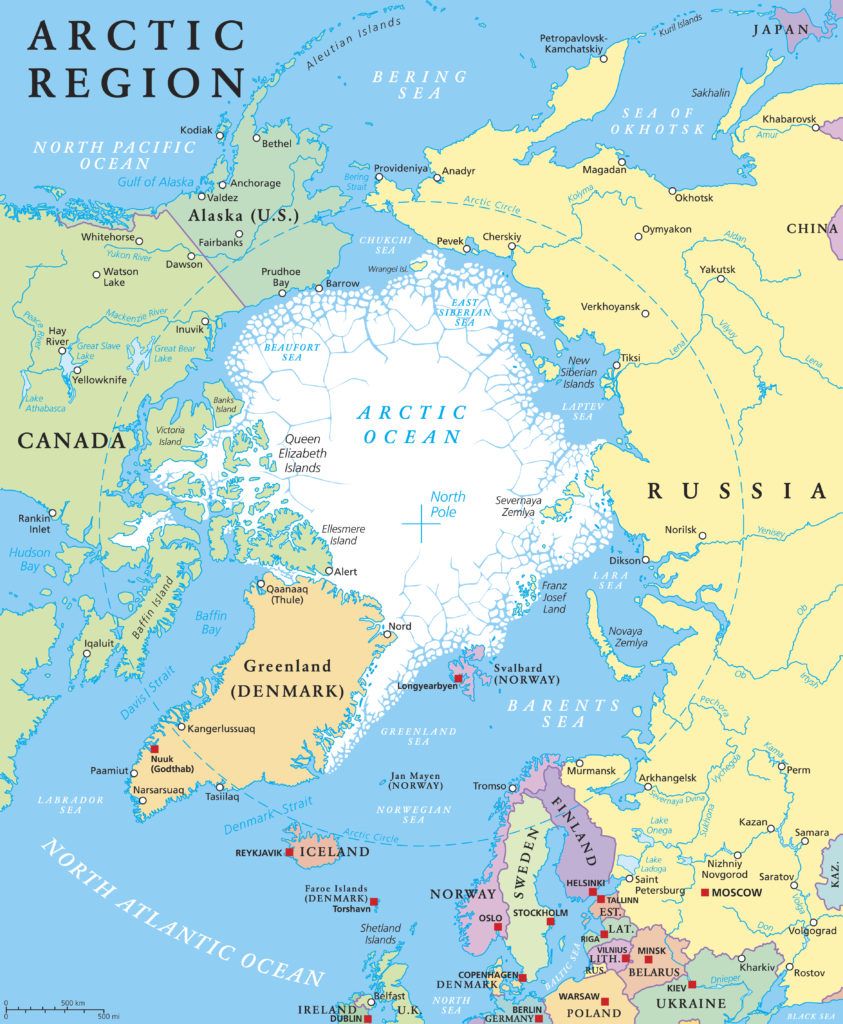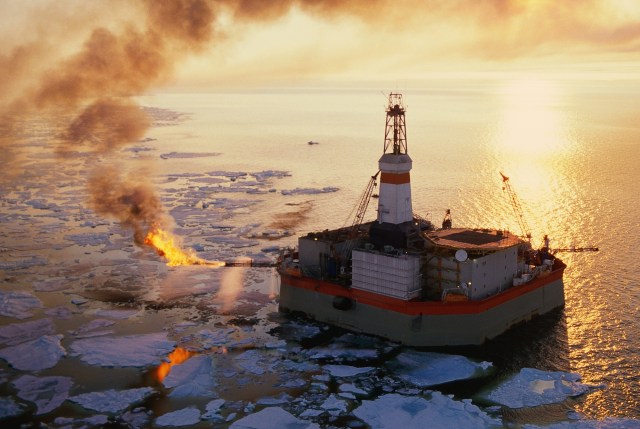
Possibly the most under-reported ‘flyover’ countries are not technically countries at all: the vast unpopulated areas around the North and South Poles. For only nerds and students of geopolitics have probably heard of the excellent (Independent) Barents Observer. It’s a newspaper established in 2002 but which – after a row – became an independent website two years ago.
For sure, thawing ice caps receive huge attention from environmental correspondents and activists. Defence experts also increasingly report on the militarisation of the Arctic – mainly by Russia. There’s also the Baltic threat which, this week, saw ten million Swedes being instructed to urgently brush up on their civil defence skills.
After allowing fifty Cold War era installations to fall into icy desuetude in the 1990s, in August 2007 Vladimir Putin signalled a return to the Arctic. A mini Russian submersible planted a metal Russian flag 4,261 metres below the North Pole. Putin compared this with the Apollo spacecraft putting the Stars and Stripes on the Moon. In 2001 Russia asserted rights over the Lomonosov Ridge, an 1,800 kilometer underwater mountainous feature, within Russia’s Arctic zone of interest, but which lies far beyond Russia’s official continental shelf. Canada and Denmark dispute that claim, which may involve billions of barrels of oil too.
The Russians are scaling up two existing Arctic warfare brigades into divisions. These heavily insulated troops move around on quadricycles or sleighs pulled by reindeer. There are also 14 operational airbases. By contrast, the Americans – who have had a big airbase at Thule on Greenland since 1951, have been slow to take an interest in the Arctic. For example, the US has one functioning icebreaker (two less than Kazakhstan has on the Caspian Sea) whereas Russia has forty, of which six are nuclear-powered. Despite the US being a founder member of the Arctic Council, which since 1996 effectively governs the north polar region, the Arctic falls through a number of US bureaucratic cracks, and the Trump administration has not appointed a new Arctic Envoy. Its pervasive scepticism towards man-made climate change does not help either.

As elsewhere, the Russians are like one of the empty shells in the old three shells hiding a pea trick. You need sharp eyes to know where the pea really is.
In 2013 the Arctic Council’s existing members – Canada, Denmark, Finland, Iceland, Norway, Russia, Sweden and the US (all of which sound pretty chilly to me) – welcomed a new observer member, even though its most northerly point is 1,000 kilometres south of the Arctic Circle. This was China, which got round mere geography by claiming that its coastal cities face catastrophic flooding from melting ice caps, which justified Beijing being an “Arctic stakeholder’”.
Some of the existing Arctic Council members were inclined to give China a warm welcome:
- Beijing helped Icelandic banks out of their plight with a $500 million currency swop, while CNOOC[1. The China National Offshore Oil Corporation] has invested heavily in offshore oil exploration.
- Greenland has benefited from an iron ore pellet mine and processing plant at Isua, while Denmark itself received a $740 million investment in the agriculture and green energy sectors.
- China supported Canada in its long running maritime dispute with the US over the North West Passage linking the Atlantic and Pacific, for Canada’s exclusive claims mirror those made by China herself in the East and South China Seas. The Chinese may also invest in developing the port of Wellington in northern Manitoba after a US company failed to make a go of it.
- Even Norway, which was put on China’s naughty step after dissident Liu Xiaobo was awarded a Nobel Prize in 2010, is back in favour in Beijing. As the biggest customer for salmon, China hit Norwegian exports to the tune of $780-1.3 billion in lost revenue. After ostentatiously refusing to meet the Dalai Lama, relations are back on track and prime minister Erna Solberg has signed a $1.45 billion deal to export salmon to China until 2025.
China says it is a team player in the Arctic, which it certainly shows through concern about global warming, fish conservation, and the fate of the indigenous Aleut, Gwich’, Inuit and Sami peoples. But it also has ambitious plans and it thinks strategically.
Although it has not been much remarked, the colossal $1-8 trillion OBOR project includes an ‘Ice Silk Road’ running north of Russia. One obvious strategic concern is that 85% of China’s energy imports (and 90% of its exports) have to pass through the Bab-el-Mandeb straits between Djibouti (where China has its first modest overseas naval base), Eritrea and Yemen, as well as the pirate-infested Malacca Straits in the Far East. The latter would be highly vulnerable to interdiction by the US Navy in the event of war. Cost is another consideration. An Arctic passage from China to Europe would shave 30% off the fuel costs, while a voyage through the inter-oceanic North West Passage rather than the Panama Canal would knock a couple of thousand nautical miles off the journey. Of course other costs mount. At present, China would have to pay transit fees to Russia, and avail herself of Russian icebreakers which are not cheap to hire. Insurance costs are pretty hefty too. But Beijing has this in hand. While it currently has one diesel-powered icebreaker, the Xuelong or Snow Dragon 1, which it bought from Ukraine in the 1990s, a nuclear-powered Snow Dragon 2 is in the works along with two more.
Although all relations between China and Russia are a case of smiles all round, or rather are “as close as lips and teeth”, as the Chinese have it, in the Arctic this might not remain the case. For sure, when Putin’s huge Yamal LNG plant ran into financial problems, China used $12 billion to acquire a 36% share, a plant which ironically enough despatched a tanker of LNG to the wintry US this month, despite the owner (Novatek) being subjected to US sanctions. Moreover, because the Russians made the mistake of limiting oil and gas exploration in the Arctic to Gazprom and Rosneft, it was not long before EU and US sanctions meant the arrival of the huge Chinese Nanhai-8 deep water drilling rig at Murmansk.
The Arctic region contains 13% of the world’s estimated undiscovered oil reserves, 30% of unrecovered natural gas deposits, and 20% of undiscovered natural gas liquids. The Arctic is also rich in diamonds, gold and nickel.
At present, the Russians seem relaxed about the arrival in the Arctic region of their cash-flush ally. But even as China acquired observer status in the Arctic Council, the then President Medvedev was quick to stress that only existing Arctic Council members make the rules because “this is natural, this is our region, we live here. This is our native land”.
One likely clash might occur were Chinese shipping to venture further north (the Chinese talk of a ‘central seaway’ nearer the Pole) beyond Russia’s 200 mile exclusive nautical zone, which would make them independent of Russia’s poor maritime infrastructure as well as the hefty transit fees the Russians are seeking (not to mention the fees for their icebreakers). Taking the long view of everything, the Chinese are confident that will soon be the case as the polar ice melts further.
At the other end of the world, the Chinese are similarly hyper active. Although their nefarious activities in Australia have recently attracted much attention, it is probably New Zealand that should be more worrying. For years they have been buying up dairy farms. Some of them seem to have been used to launch high altitude balloons, which may be connected some suspect, to China’s interest in low orbital space warfare, in which they would blind US military communications satellites on Day One. As elsewhere, some in New Zealand are worried about the (intelligence) backgrounds of members of parliament from the Chinese diaspora, not to mention the fact that three of New Zealand’s last four prime ministers are directors of mainland Chinese banks.










Join the discussion
Join like minded readers that support our journalism by becoming a paid subscriber
To join the discussion in the comments, become a paid subscriber.
Join like minded readers that support our journalism, read unlimited articles and enjoy other subscriber-only benefits.
Subscribe